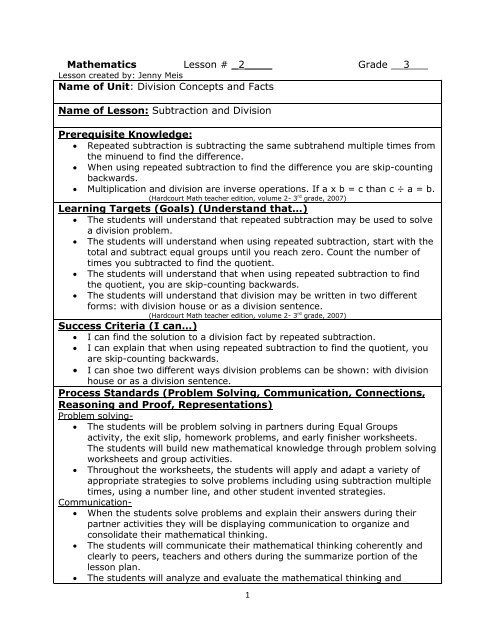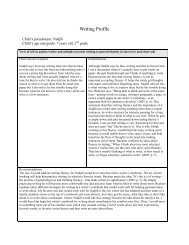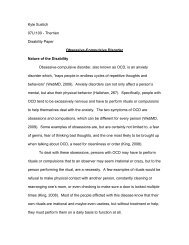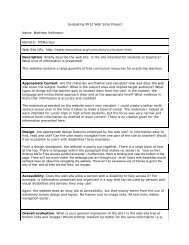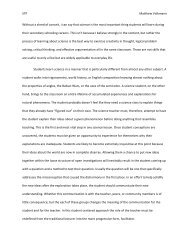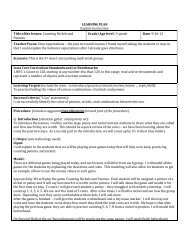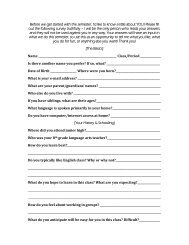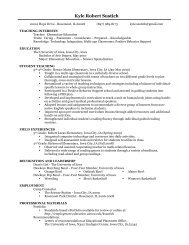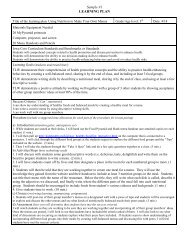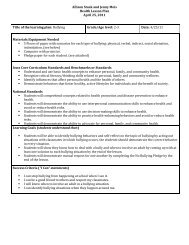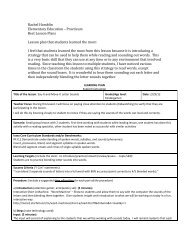07E:163 Methods: Elementary School Mathematics - Employment
07E:163 Methods: Elementary School Mathematics - Employment
07E:163 Methods: Elementary School Mathematics - Employment
Create successful ePaper yourself
Turn your PDF publications into a flip-book with our unique Google optimized e-Paper software.
<strong>Mathematics</strong> Lesson # _2____ Grade __3___<br />
Lesson created by: Jenny Meis<br />
Name of Unit: Division Concepts and Facts<br />
Name of Lesson: Subtraction and Division<br />
Prerequisite Knowledge:<br />
Repeated subtraction is subtracting the same subtrahend multiple times from<br />
the minuend to find the difference.<br />
When using repeated subtraction to find the difference you are skip-counting<br />
backwards.<br />
Multiplication and division are inverse operations. If a x b = c than c ÷ a = b.<br />
(Hardcourt Math teacher edition, volume 2- 3 rd grade, 2007)<br />
Learning Targets (Goals) (Understand that…)<br />
The students will understand that repeated subtraction may be used to solve<br />
a division problem.<br />
The students will understand when using repeated subtraction, start with the<br />
total and subtract equal groups until you reach zero. Count the number of<br />
times you subtracted to find the quotient.<br />
The students will understand that when using repeated subtraction to find<br />
the quotient, you are skip-counting backwards.<br />
The students will understand that division may be written in two different<br />
forms: with division house or as a division sentence.<br />
(Hardcourt Math teacher edition, volume 2- 3 rd grade, 2007)<br />
Success Criteria (I can…)<br />
I can find the solution to a division fact by repeated subtraction.<br />
I can explain that when using repeated subtraction to find the quotient, you<br />
are skip-counting backwards.<br />
I can shoe two different ways division problems can be shown: with division<br />
house or as a division sentence.<br />
Process Standards (Problem Solving, Communication, Connections,<br />
Reasoning and Proof, Representations)<br />
Problem solving-<br />
The students will be problem solving in partners during Equal Groups<br />
activity, the exit slip, homework problems, and early finisher worksheets.<br />
The students will build new mathematical knowledge through problem solving<br />
worksheets and group activities.<br />
Throughout the worksheets, the students will apply and adapt a variety of<br />
appropriate strategies to solve problems including using subtraction multiple<br />
times, using a number line, and other student invented strategies.<br />
Communication-<br />
When the students solve problems and explain their answers during their<br />
partner activities they will be displaying communication to organize and<br />
consolidate their mathematical thinking.<br />
The students will communicate their mathematical thinking coherently and<br />
clearly to peers, teachers and others during the summarize portion of the<br />
lesson plan.<br />
The students will analyze and evaluate the mathematical thinking and<br />
1
strategies of others during partner activities and through showing multiple<br />
representations for a solution through the finish the solution questioning<br />
strategy in their homework assignment.<br />
The students will use the language of mathematics to express mathematical<br />
ideas precisely by explaining their thinking when articulating their solution to<br />
a problem to partners and in the class discussions.<br />
Reasoning and Proof-<br />
The students will select and use various types of reasoning and methods of<br />
proof through completing the partner activities and using different methods<br />
of representation for repeated subtraction. They will also show reasoning<br />
and proof through their own invented strategies and using others.<br />
Representations-<br />
The students will create and use representations to organize, record, and<br />
communicate mathematical ideas through using number lines and invented<br />
strategies for repeated subtraction.<br />
The students will select, apply, and translate among mathematical<br />
representations to solve problems by selecting the one they are most<br />
comfortable with as well as using some outside their comfort zone in the<br />
Extra Practice homework problems.<br />
The students will use representations such as a number line and invented<br />
strategies to model and interpret physical, social, and mathematical<br />
phenomena through repeated subtraction.<br />
Materials and Preparation:<br />
Hardcourt Math teacher edition, volume 2<br />
Worksheets and answer keys to each worksheet:<br />
(print out in different colors) (Attached)<br />
- Equal Groups<br />
- My Exit Slip<br />
-Relay Teams and Separating the Colors (early finisher)<br />
- Extra Practice! (homework)<br />
A group folder for each table that includes all of the worksheets listed above<br />
If using an overhead rather than a Smartboard- 3 transparency sheets for<br />
the warm-up<br />
Observation clipboard<br />
Warm-up/Opener:<br />
At your tables, draw one model as a group of how 18 can be divided into groups<br />
evenly and create a number sentence for it.<br />
6x3=18/ 3x6=18 (they may also have written division problems)<br />
1x 18=18/ 18x1=18<br />
9x2=18/ 2x9=18<br />
When you’re finished, try to find additional ways 18 can be divided up evenly.<br />
Have groups hold up their model when teacher says 1, 2, 3, Reveal!!<br />
2
Talk about all possible answers. Then, call on a student that thinks they can count<br />
on a number line to show this same number sentence. Have them show it on the<br />
overhead. (18÷8=2)<br />
2 1<br />
(You skip-count backwards, or subtract 2 times to from 18 to 0. That means 18÷8=2)<br />
Ask Students:<br />
Billy said division is like repeated addition. Do you agree or disagree? Explain why.<br />
Disagree. To find the quotient in a division problem you have to count how<br />
many times you skip-count backwards to find the quotient. Repeated subtraction if<br />
used in multiplication the product. That means you are skip counting forwards.<br />
Does anyone have any other suggestions for how we can show 18÷8=2?<br />
18 9<br />
-9 -9<br />
9 0<br />
Ask Students:<br />
“How is division like subtraction?”<br />
They both separate objects into equal groups.<br />
Other Possible answers:<br />
They both subtract numbers. If this is said, reply by suggesting you were<br />
talking about objects rather than just numbers.<br />
Ask students to show as a group two different ways or symbols division can be<br />
written. (Use 1, 2, 3, Reveal!!)<br />
÷ and<br />
(Questions and teaching adapted by (Meis, 2001) from Hardcourt Math teacher edition, volume 2- 3 rd grade, 2007)<br />
Launch:<br />
When I say “go,” I want everyone to get with their summer partners.(they will know<br />
what this means. If someone does not have a partner due to an absent student, place them with<br />
another group to make a group of 3). Right now, I need everyone to grab their “(color)”<br />
“equal Groups” worksheet sheet and the “(color)” Early finisher worksheet from<br />
your group folder.<br />
What you’re going to do once you find your partner, is complete the equal<br />
groups worksheet together. Make sure both partners can explain how they<br />
found the solutions to the problems. When you get to #4, try to come up<br />
with a strategy we have not talked about already.<br />
3
When you and your partner are finished, I would like you to work on your<br />
Early Finisher Worksheets.<br />
Before heading to your groups, you need to take with you your “(color)”<br />
Equal Groups worksheet sheet, and your Relay teams and Separating the<br />
Colors (Early Finisher activity), and a pencil with you.<br />
Ok, get with your summer partner. “GO!”<br />
Explore:<br />
A.) Anticipated student questions, teacher questions, and answers can be found<br />
on the worksheets. (see attached)<br />
B.) I will be doing my assessment through anecdotal notes on my teacher<br />
clipboard. I will be observing and taking notes about what students are<br />
struggling, which students need further challenged, common questions and<br />
misconceptions I see throughout the activity that need to be discussed when<br />
we come back together as a class.<br />
C.) Formative assessment:<br />
Agree/ Disagree questioning strategy in the early finisher(see warmup)<br />
Fit the condition questioning strategy (See Exit Slip)<br />
Finish the Solution questioning Strategy (See Extra Practice!)<br />
Add in color strategy to add anything they think is important to their<br />
array and variable worksheet when we go over it in class<br />
The teacher will be using formative assessment by taking anecdotal<br />
notes during the Equal Groups partner worksheet to see what students<br />
aren’t getting about division. These concerns or misconceptions will be<br />
addressed during the summative portion of the lesson.<br />
D.) Differentiated Questions/Tasks:<br />
The advanced partnerships that finish the Equal Groups partner<br />
activity quickly will have an early finisher activity that will challenge<br />
them further.<br />
Since they are working with partners, if they end up being at two<br />
different levels in division, they will help each other. The advanced<br />
student will gain deeper understanding by explaining things in different<br />
ways and the lower level partner will get things explain to them in a<br />
way they might grasp better understanding.<br />
E.) Early Finisher (“Relay Teams and Separating the Colors” See attached)<br />
Summarize:<br />
A.) Students will share the results and understanding of the Equal Groups<br />
worksheet together as a class discussion. If they hear something they<br />
4
think is important they will be instructed to add it to their Equal Groups<br />
sheet in colored pencil.<br />
B.) Key mathematical ideas that must be discussed include:<br />
Repeated subtraction may be used to solve a division problem.<br />
When using repeated subtraction, start with the total and subtract<br />
equal groups until you reach zero. Count the number of times you<br />
subtracted to find the quotient.<br />
When using repeated subtraction to find the quotient, you are skipcounting<br />
backwards.<br />
Division may be written in two different forms: with division house<br />
or as a division sentence.<br />
C.) Check for Understanding- They will show their understanding of the lesson<br />
by completing a fit the condition questioning strategy worksheet and<br />
showing a model that represents the division problem. (Exit Slip-<br />
attached)<br />
Application:<br />
Students will apply what they learned through the lesson by doing homework<br />
problems that require knowledge of division as repeated subtraction, ways to model<br />
it, and number sense. (Extra practice!- See attached)<br />
5
<strong>Mathematics</strong> Lesson # _3____ Grade __3___<br />
Lesson created by: Jenny Meis<br />
Name of Unit: Division Concepts and Facts<br />
Name of Lesson: Multiplication and Division<br />
Prerequisite Knowledge:<br />
Know how to find a quotient by using an array by count the number in each<br />
row.<br />
Use a related multiplication fact to find a quotient.<br />
Multiplication and division are inverse operations. If a x b = c than c ÷ a = b.<br />
(Hardcourt Math teacher edition, volume 2- 3 rd grade, 2007)<br />
Learning Targets (Goals) (Understand that…)<br />
The students will understand what it means to relate division to multiplication<br />
The students will understand and use multiplication and division fact families<br />
The students will understand what a variable is and how to find it’s solution<br />
through using fact families and an array<br />
(Hardcourt Math teacher edition, volume 2- 3 rd grade, 2007)<br />
Success Criteria (I can…)<br />
I can find the solution to a division fact by relating it to multiplication.<br />
I can find the solution to a division problem using fact families and an array<br />
I can tell you that a variable is an unknown number in a number sentence<br />
and I can find the solution for the variable by using fact families or an array<br />
Process Standards (Problem Solving, Communication, Connections,<br />
Reasoning and Proof, Representations)<br />
Problem solving-<br />
The students will be build mathematical knowledge through problem solving<br />
working with partners during the Break It In Parts activity, the worksheet on<br />
arrays and variables, the exit slip, and the homework problems.<br />
Throughout the worksheets, the students will apply and adapt a variety of<br />
appropriate strategies to solve problems including the array model and<br />
student invented strategies. The students will be problem solving in partners<br />
during the Equal Groups activity, early finisher worksheets. The students will<br />
build new mathematical knowledge through problem solving worksheets<br />
individually as well as in group activities.<br />
Throughout the worksheets, the students will apply and adapt a variety of<br />
appropriate strategies to solve problems including using break apart cubes,<br />
array models, and student invented strategies.<br />
Connections-<br />
The students will recognize and use connections among mathematical ideas<br />
by relating multiplication and division. This will also help them understand<br />
how mathematical ideas interconnect and build on one another to produce a<br />
coherent whole.<br />
The students will recognize and apply mathematics in contexts outside of<br />
mathematics through story problems in their worksheets.<br />
Communication-<br />
When the students solve problems and explain their answers during their<br />
6
partner activities they will be displaying communication to organize and<br />
consolidate their mathematical thinking.<br />
The students will communicate their mathematical thinking coherently and<br />
clearly to peers, teachers and others during the warm-up and summarize<br />
portion of the lesson plan.<br />
The students will analyze and evaluate the mathematical thinking and<br />
strategies of others during partner activities and through showing multiple<br />
representations for a solution through warm up, and division with Arrays and<br />
variables worksheet.<br />
The students will use the language of mathematics to express mathematical<br />
ideas precisely by explaining their thinking when articulating their solution to<br />
a problem to partners as well as in the class discussions. They will also<br />
explain their mathematical language n an individual basis by completing the<br />
exit slip.<br />
Reasoning and Proof-<br />
When the students are completing the partner activities they, they will be<br />
reasoning and proving why they chose the answers they did. This will help<br />
them determine if their solutions make sense. Another time they are using<br />
reasoning and proof skills is by answering the reasonable/unreasonable<br />
questioning strategy during warm-up.<br />
The students will select and use various types of reasoning and methods of<br />
proof through completing the partner activities and using different methods<br />
of representation multiplication. They will also show reasoning and proof<br />
through their own invented strategies and the use others.<br />
Representations-<br />
The students will create and use representations to organize, record, and<br />
communicate mathematical ideas through using Break Apart manipulates<br />
during the “Break It In Parts” activity.<br />
The students will select, apply, and translate among mathematical<br />
representations to solve problems by selecting the one they are most<br />
comfortable with as well as using some outside their comfort zone in the<br />
Extra Practice homework problems.<br />
The students will use representations such as Break Apart cubes and<br />
invented strategies to model and interpret physical, social, and mathematical<br />
phenomena by dividing through multiplication.<br />
Materials and Preparation:<br />
Hardcourt Math teacher edition, volume 2<br />
Worksheets and answer keys to each worksheet:<br />
(print out in different colors) (Attached)<br />
- Build it in Parts<br />
- Arrays and Variables<br />
- What’s the Meaning of 0 (early finisher)<br />
- Extra Practice! (homework)<br />
A group folder for each table that includes all of the worksheets listed above<br />
Break apart cubes (enough for each pair of students can have at least 12 in<br />
two different colors<br />
If using an overhead rather than a smartboard- 3 transparency sheets for the<br />
7
warm-up<br />
Observation clipboard<br />
Warm-up/Opener:<br />
Draw an array showing 18÷ 3= 6. Explain how you can look at your array 2<br />
different ways and still see 18÷3=6. ( 6 groups of 3; 3 groups of 6)<br />
Teacher Questions:<br />
“Think 3x6=18.”<br />
“What do you know about 3x6?”<br />
(3x4=12 is the same thing as having 4 groups of 3 to equal 12 altogether)<br />
In this division problem, what number is the divisor? Dividend? Quotient?<br />
18÷ 3= 6<br />
Dividend Divisor Quotient<br />
(Write on overhead or smartboard)<br />
Ask Students:<br />
Amy Says multiplication and division are opposite or inverse operations. Do you<br />
think this is reasonable or unreasonable? Why?<br />
Reasonable. The operations are opposite because multiplication puts together<br />
equal groups while division separates equal groups.<br />
(Questions and teaching adapted by (Meis, 2001) from Hardcourt Math teacher edition, volume 2- 3 rd grade, 2007)<br />
Launch:<br />
When I say “go,” I want everyone to get with their fall partners.<br />
(They will know what this means. If someone does not have a partner due to an absent student, place<br />
them with another group to make a group of 3).<br />
But first, I need everyone to grab their “(color)” Build It in Parts worksheet sheet<br />
and the “(color)” Arrays and Variables worksheet, and the “(color)” Early finisher<br />
worksheet from your group folder.<br />
What you’re going to do once you find your partner, is have one person grab<br />
a box of break-a-part cubes. Then you and your partner will decide on a<br />
number between 5 and 12. I’m going to choose 8 to demonstrate. I know<br />
that 4x2=8, so 4 green cubes and another 4 blue cubes will make 8 Now, I<br />
am going to color on the grid paper that 4 green plus 4 blue equal 8 and<br />
write the equation for it underneath my array. (Ask if anyone knows any<br />
other facts that make 8. Should get the answer 8x1=8) (Demonstrate<br />
drawing the arrays as well)<br />
(Demonstrate on overhead or smartboard)<br />
When you think you have found all the possible combinations to make the<br />
first number you and your partner has chosen, choose a number larger than<br />
the first to challenge yourselves. Do this with different 3 numbers and then<br />
8
choose your favorite example you have made to share with your table group<br />
after the partner activities. After your example is chosen, double checks to<br />
make sure you have found all the possible solutions. Then, work on the<br />
“(color)” Arrays and Variables worksheet with your partner. If you get<br />
finished with both of those activities work on your Early Finisher worksheet.<br />
You need to take with you, your “(color)” Build It in Parts worksheet sheet,<br />
the “(color)” Variables worksheet, The meaning of 0 (Early Finisher activity),<br />
a pencil, and your colored pencils with you.<br />
Ok, get with your fall partner. “GO!”<br />
Explore:<br />
F.) Anticipated student questions, teacher questions, and answers can be found<br />
on the worksheets. (see attached)<br />
G.) I will be doing my assessment through anecdotal notes on my teacher<br />
clipboard. I will be observing and taking notes about what students are<br />
struggling, which students need further challenged, common questions and<br />
misconceptions I see throughout the activity that need to be discussed when<br />
we come back together as a class.<br />
H.) Formative assessment:<br />
Reasonable/unreasonable strategy in the warm up (see warm-up)<br />
Agree/ Disagree strategy in the early finisher (see attached)<br />
Fit the condition questioning strategy (See Extra Practice!)<br />
Add in color strategy to add anything they think is important to their<br />
array and variable worksheet when we go over it in class<br />
The teacher will be using formative assessment by taking anecdotal<br />
notes during the Break It in Parts activity and the Arrays and Variable<br />
worksheet with their partners<br />
I.) Differentiated Questions/Tasks:<br />
Build It in Parts - This activity is designed in a way that can be easily<br />
tiered. For the struggling students I will have them try to demonstrate<br />
smaller numbers and for the advanced student I will have them work<br />
on numbers above 12 that will be more challenging for those<br />
individuals.<br />
Once the students have mastered a smaller number they are<br />
instructed to break a part a bigger number that will have more factors<br />
and therefor more challenging.<br />
The advanced students who finish the partner activities quickly also<br />
will have an early finisher activity that will challenge them.<br />
J.) Early Finisher (“What’s the Meaning of 0? Early finisher- Attached)<br />
9
Summarize:<br />
D.) Students will share the results from their break it in parts activity with<br />
their table groups. Then, we will go over and finish the variables<br />
worksheet together as a class. If they hear something they think is<br />
important they will be instructed to add it to their sheet in colored pencil.<br />
E.) Key mathematical ideas that must be discussed include:<br />
How division and multiplication are related.<br />
How fact families are used when using multiplication to divide.<br />
How a variable and array can be used for division.<br />
F.) Check for Understanding- They will explain how to use an array to<br />
multiply and divide. They will write the division equation for the provided<br />
array and an additional equation that includes a variable. (Exit Slip-<br />
attached)<br />
Application:<br />
Students will apply what they learned through the lesson by doing homework<br />
problems that require knowledge of division, fact families, and number sense.<br />
(Extra practice!- See attached)<br />
10
<strong>Mathematics</strong> Lesson # _4____ Grade __3___<br />
Lesson created by: Jenny Meis<br />
Name of Unit: Division Concepts and Facts<br />
Name of Lesson: Fact Families<br />
Prerequisite Knowledge:<br />
Multiplication facts through 10<br />
Know how to make equal groups<br />
A fact family is a set of related multiplication and division sentences.<br />
Think of the quotient or missing divisor as one of the missing factors in the<br />
related multiplication sentence.<br />
To use a related multiplication table and related multiplication fact to find a<br />
quotient in the top row, look down to find the dividend, and then look to the<br />
left to find the missing number.<br />
(Hardcourt Math teacher edition, volume 2- 3 rd grade, 2007)<br />
Learning Targets (Goals) (Understand that…)<br />
The students will understand they can use related multiplication facts to find<br />
quotients or missing divisors in division sentences.<br />
The students will understand you cannot write a division sentence using a<br />
smaller dividend than the divisor and still get a whole number.<br />
The students will know that they can use a multiplication table to find the<br />
missing quotient or divisor in a division sentence.<br />
(Hardcourt Math teacher edition, volume 2- 3 rd grade, 2007)<br />
Success Criteria (I can…)<br />
I can use multiplication and division fact families to help me find the missing<br />
variable in a division or multiplication problem.<br />
If I write a division sentence using a smaller dividend than the divisor I will<br />
not get a whole number. I will get a fraction.<br />
I can find the missing quotient or divisor by using a multiplication table.<br />
Process Standards (Problem Solving, Communication, Connections,<br />
Reasoning and Proof, Representations)<br />
Problem solving-<br />
The students will build new mathematical knowledge through solving<br />
problems with variables, writing fact families with their Triangular Fact Family<br />
cards, and completing the Extra Practice! homework problems to reinforce<br />
their new skills.<br />
Students will apply and adapt a variety of appropriate strategies to solving<br />
problems with missing variables. This will be demonstrated through the<br />
Triangle Family Fact cards, the variable worksheet, the early finisher, as well<br />
as the Extra Practice! homework problems.<br />
The students will monitor and reflect on the process of mathematical problem<br />
solving by using the smile face self-assessment tool (putting a happy,<br />
uncertain, or sad face by any math problem they do during this lesson to let<br />
themselves as well as me know what they are doing well with and what they<br />
need more help with.<br />
11
Communication-<br />
The students will solve problems and explain their answers during the<br />
activities (Triangle Fact Family Cards, and multiplication table worksheet)<br />
and displaying communication to organize and consolidate their<br />
mathematical thinking.<br />
The students will communicate their mathematical thinking coherently and<br />
clearly to peers, teachers and others during the summarize portion of the<br />
lesson plan and the warm-up by discussing and agreeing on a common<br />
solution.<br />
The students will analyze and evaluate the mathematical thinking and<br />
strategies of others during the warm-up group discussion and the summarize<br />
portions of the lesson plan.<br />
Advanced students and struggling learners will show multiple representations<br />
for a division sentence with the same quotient during the Extra Practice!<br />
homework problems.<br />
The students will use the language of mathematics to express mathematical<br />
ideas precisely by explaining their thinking when articulating their solution to<br />
problems during group and whole class discussions as well as individually on<br />
the Extra Practice! and multiplication table worksheets.<br />
Connections-<br />
The students will be making connections in this lesson by relating fact<br />
families (multiplication problems) to division problems to help them find out<br />
a missing variable. They will also be making connections and building number<br />
sense through using a multiplication table in their multiplication table<br />
worksheet.<br />
Working with a multiplication table and making their own fact family cards<br />
will allow the student interconnect and build on existing mathematical<br />
knowledge to produce a coherent whole.<br />
Reasoning and Proof-<br />
The students will select and use various types of reasoning and methods of<br />
proof through using a multiplication table to find variable in a division<br />
number sentence as well as through using their fact family cards.<br />
Representations-<br />
The students will create and use representations to organize, record, and<br />
communicate mathematical ideas through making their own triangular fact<br />
family cards during the explore phase.<br />
The students will select, apply, and translate among mathematical<br />
representations to solve problems by selecting the strategies that work the<br />
best for them for a certain problem during their Extra Practice! homework<br />
problems.<br />
The students will use representations such as a multiplication table and their<br />
fact family cards to develop strategies to model and interpret physical, social,<br />
and mathematical phenomena through multiplication.<br />
Materials and Preparation:<br />
Hardcourt Math teacher edition, volume 2<br />
Worksheets (1 for each student)and answer keys to each worksheet:<br />
12
(print out in different colors)<br />
-Directions to the Triangle Fact Family activity and 1 piece of colored paper<br />
- Multiplication Table and worksheet<br />
- Fact Families(early finisher)<br />
- Extra Practice! (homework)<br />
A group folder for each table that includes all of the worksheets listed above<br />
If using an overhead rather than a smartboard- 3 transparency sheets for the<br />
warm-up.<br />
Observation clipboard<br />
Students will need their scissors<br />
Warm-up/Opener:<br />
This error analysis questioning strategy will be displayed or written on the board.<br />
Students will first work on it by themselves and then discuss it with their table<br />
groups.<br />
Victoria says 3 ÷ 4 = 12. What error is she making?<br />
Victoria is writing the problem wrong because she is switching around the<br />
divisor and the dividend. She has the dividend as 3 and the divisor as 4.<br />
Teacher Questions:<br />
“Think about the parts of a division problem that we learned yesterday.”<br />
Divisor, dividend, and quotient.<br />
“What does the divisor mean in an array? Dividend?<br />
Divisor-The total number of rows and columns<br />
Dividend- The number of rows.<br />
Once you discuss as a whole group what she is doing wrong have each group write<br />
the division problem the correct way on whiteboards, one per group. Have them<br />
label each part of the problem.<br />
12 ÷ 3 = 4<br />
Dividend Divisor Quotient<br />
(Write all answers from groups on the overhead or smartboard. Then have them choose as a group<br />
which one is correct)<br />
Ask Students:<br />
Can anyone come up with an equation for Victoria’s problem by switching the<br />
operation? Explain your thinking.<br />
3 x 4 = 12 because multiplication is the inverse operation of division. You can<br />
put the little number first in multiplication because it doesn’t matter what<br />
comes first. 3x4 is the same as 4x3. But in division, if you divide a smaller<br />
number from a larger number you will get a fractional number. Like 2÷ 4 =<br />
½.<br />
Demonstrate the 2÷ 4 = ½ issue with a pizza if students can’t explain why<br />
13
they will get a fraction.<br />
(Questions and teaching adapted by (Meis, 2001) from Hardcourt Math teacher edition, volume 2- 3 rd grade, 2007)<br />
Launch:<br />
The students will Make their own set of triangle fact cards for each of these<br />
products: 12, 15, 18, 20, 24, 25, and 30. They will be doing this in their table<br />
groups.<br />
Before the students do it on their own, make a triangle family fact card for the<br />
product of 15 together on the overhead or smartboard.<br />
Factor Factor<br />
Product<br />
A. First, you will fold each paper in half 3 times. Open up the paper and cut<br />
along the folds to make triangle cards.<br />
B. Make triangle facts for each of these products: 12, 15, 18, 20, 24, 25, and<br />
30.<br />
C. Write fact families for at least 3 triangle fact cards.<br />
When you have completed your Triangle Fact Family cards work on your<br />
Multiplication Table worksheet/activity.<br />
You will find the directions and the paper you need in your group folder. Get that<br />
out now along with the Multiplication table worksheet and the Early Finisher. You<br />
will also need scissors from your desk. If you get done early work on the Early<br />
finisher activity.<br />
Explain to the students that today you would also like them to put a :l <br />
(happy, middle, or sad face by any math problem they complete today to let me<br />
know what you understand and what you aren’t so sure about.<br />
Explore:<br />
K.) Anticipated student questions, teacher questions, and answers can be found<br />
on the worksheets. (see attached)<br />
14
L.) Formative Assessment Strategies and questions:<br />
I will be doing my assessment through anecdotal notes on my teacher<br />
clipboard. I will be observing and taking notes about what students are<br />
struggling, which students need further challenged, common questions and<br />
misconceptions I see throughout the activity that need to be discussed when<br />
we come back together as a class.<br />
I will also have the students self-assess by way of happy, uncertain, or sad<br />
face smiles by any math problems they do to let themselves as well as me<br />
know what they are going great with and what they need a little extra help<br />
with.<br />
Error Analysis questioning strategy in the warm up (see warm-up)<br />
The teacher will be using formative assessment by taking anecdotal notes<br />
during the Triangle Fact Family activity<br />
Reasonable/ unreasonable questioning strategy in Extra Practice! Homework<br />
assignment<br />
Revise in color if they have a wrong factor for a Triangle fact family card or<br />
have written a wrong fact family equation (See the Summarize portion of the<br />
lesson)<br />
M.) Differentiated Questions/Tasks:<br />
Triangle Fact Family activity- This activity has been designed to be<br />
tiered easily. For the struggling student, I will have them create fact<br />
family cards for smaller quotients.<br />
4 ÷2 10÷5 (landmark numbers)<br />
If the struggling students still don’t seem to be getting a grasp on<br />
division, I will introduce them to counting by multiples.<br />
20÷5= (4)<br />
(count by fives up to 20. Keep track of how many times you count to get to the<br />
dividend)<br />
For the advanced student (I will notice them because they will be<br />
working on the different colored Early Finisher worksheet)who might<br />
get done relatively quickly, I will have them write division sentences<br />
that has the same quotient as the division sentences below:<br />
24÷3=8 Possible Solutions: 16÷2=8; 40 ÷5=8<br />
18÷2=9 27÷3=9; 36÷4=9<br />
The early finisher can also be used as a challenge for the advanced<br />
student.<br />
N.) Early Finisher (“Fact families” - Attached)<br />
Summarize:<br />
G.) When finished with the Triangle fact family activity, I will have all of the<br />
students come together and go over their fact Triangle cards as a class. If<br />
they have wrong factors or something wrong in a fact family equation,<br />
they will be instructed to revise in color.<br />
15
H.) Key mathematical ideas that must be discussed include:<br />
Each Triangle fact family card has 2 multiplication equations and 2<br />
division equations.<br />
They can use related multiplication facts to find quotients or missing<br />
divisors in division sentences.<br />
Multiplication tables and how to use them to find variables.<br />
I.) Check for Understanding (Exit Slip- attached)<br />
Application:<br />
Students will apply what they learned through the lesson by doing homework<br />
problems that require them to practice the skills they learned today such as how a<br />
division sentence can use the same numbers as a multiplication sentence and how<br />
to use a multiplication table to find solutions to division problems. (Extra practice!-<br />
See attached)<br />
16
Name:___________________ Number__________<br />
Write the fact family.<br />
1. 2, 7, 14<br />
___________________<br />
___________________<br />
___________________<br />
___________________<br />
2. 6, 9, 59<br />
___________________<br />
___________________<br />
___________________<br />
___________________<br />
3. 8, 23<br />
___________________<br />
___________________<br />
___________________<br />
___________________<br />
Lesson 4- Quiz<br />
4. 4, 5, 20<br />
___________________<br />
___________________<br />
___________________<br />
___________________<br />
Hardcourt Math teacher edition, volume 2- 3 rd grade, 2007
Name:___________________ Number__________<br />
Write the fact family.<br />
1. 2, 7, 14<br />
2 x 7 = 14 7 x 2 = 14 14/2=7 14/7=2<br />
2. 6, 9, 59<br />
6 x 9 = 54 9 x 6= 54 54/9=6 54/6=9<br />
3. 4, 8, 23<br />
4 x 8 = 32 8 x 4 = 32 32/4=8 32/8=4<br />
4. 4, 5, 20<br />
4 x 5 = 20 5 x 4 = 20 20/5=4 20/4=5<br />
Hardcourt Math teacher edition, volume 2- 3 rd grade, 2007


